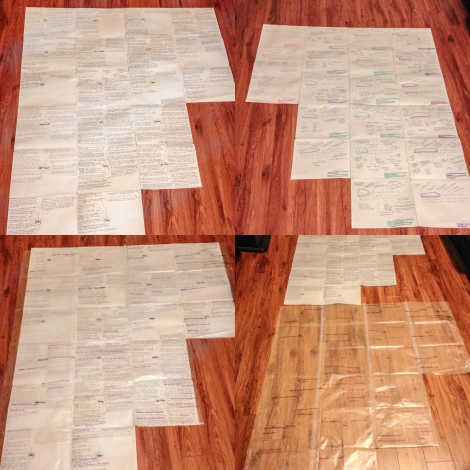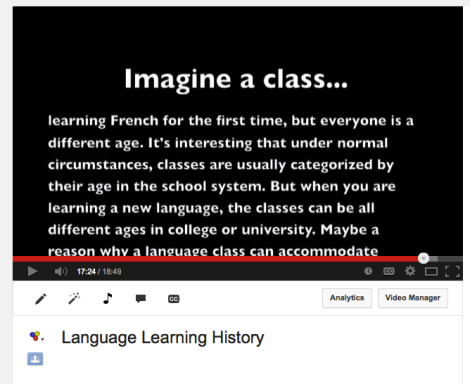A Dramatic Approach to Multiliteracies Assessment
Introduction: A True Story of the Power of Multiliteracies
A multiliteracies student took a course where they had to read academic articles and write in a traditionally academic way. They were dealing with heavy academic language and hefty theoretical frameworks. This student tried to develop her own meaning making through an exquisitely elaborate mindmap that her professor said “…has never seen before.” As a first year graduate student, she tried to intrinsically learn the material and develop her own interpretations of the material. However, she could only display her knowledge through three academic papers. Needless to say, when her knowledge had to be applied in only traditional academic papers, she received a B in this class.
 Figure 1: A meaning making mindmap
Figure 1: A meaning making mindmap
[Top left: A curation of quotes that resonated]
[Top right: All of the questions that were raised while reading]
[Bottom: finding common themes by using parchment paper that overlaid the mindmap
and highlighting important key concepts that connected]
This multiliteracies student took another course with the same academic rigour but there was a freedom that was welcomed in terms of assignment formats. Students could choose to write the traditional academic paper, or submit another format that is original and creative. This student chose the latter. She submitted an iMovie, where she spent 8 hours creating, but another 5 hours putting together video clips. She used 3 interviews, many visual images and incorporated 2 journal articles to back up her claims. When given the opportunity to apply her knowledge and experiences in a non-traditional format, she exceeded expectations and received 90% on this assignment.
 Figure 2: An iMovie screenshot
Figure 2: An iMovie screenshot
The question is how do we assess multiliteracies and in particular for higher education. In this particular true story, this student benefited from applying her knowledge in a multimodal way through an iMovie because she followed all the expectations and had an element of originality and creativity that is highly valued in a graduate student.
However, in this particular circumstance, what should be considered when assessing blog posts?
Before I Begin
Through my own experience, the following are criteria that I thought would be important to assessing blog posts. This is a collection of my own thoughts and ideas. After this section, will be a connection between assessment and literature.
- Have the quantity of posts (3 postings) been met?
- Has the word count (300-500 words) been met?
- Are references/figures/bibliography in APA format?
- Are there hyperlinks (1-2) to credible and helpful resources?
- Do thoughts and questions signify student’s critical thinking and analytical understanding?
- Are visuals/videos (1-2) used?
- How many comments have they moderated and replied to (1-2 comments)?
- Layout is comprehensible and can guide a reader
- Tags have been used in comparison to “key words”
- Esthetics or technical ability not assessed
- Altmetrics will not be assessed
An Assessment of Blogs in Higher Education
When looking at blogs, several different qualities can be assessed.
The scale used would be: YES, SOMEWHAT, NO
The following criteria are adapted from Bearne (2009):
- Decide on mode and content for specific purpose and audience (p. 22)
– communicate meaning for specific purposes (deciding on words rather than images, or gesture/music rather than words) (p. 22)
– adapt, synthesize and shape content to suit personal intentions in communication (p. 22) - Structure texts (p. 22)
– pay conscious attention to design and layout of texts
– use structual devices (pages, sections, paragraphs, blocks of text) to organize texts - Reflect (p. 23)
– explain choices of mode(s) and expressive devices including words (p. 23)
– improve own composition or performance (p. 23)
– reshaping, redesigning, redrafting for purpose and readers’/viewers needs (p. 23) - Used three modes: images (moving and still, diagrammatic, or representational), sound (spoken words, sound effects and music), writing (typographical elements of font type, size and shape) (p. 16).
Justifications for this assessment
- I believe that “learners will need to be flexible, collaborative and versatile” (Bearne, 2009, p. 17).
- I am “an assured, experienced, and independent multimodal text maker” (Bearne, 2009, p. 23). However I recognize that graduate students may be a multimodal text maker in the early stages; an increasingly assured multimodal text maker; or a more experienced and often independent multimodal text maker (Bearne, 2009, p. 23)
- A formative assessment: to give them feedback on their learning, as they learn. Assessment integrated with and for learning (Cope & Kalantzis, 2000)
References
Bearne, E. (2009). Assessing multimodal texts. In A. Burke & R.F. Hammett (Eds). Assessing new literacies: Perspectives from the classroom (pp 15-34). New York: Peter Lang.
Cope, B., & Kalantzis, M. (Eds). (2000). Literacies standards and assessment. In Multiliteracies: Literacy learning and the design of social futures (Chapter 15, pp. 401-420). London: Routeledge.
